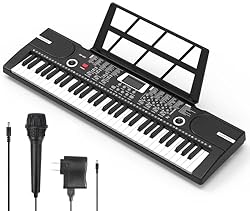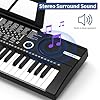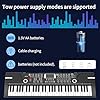Table of Contents
Introduction to Building a Solid Foundation in Piano Basics
Learning to play the piano is an exciting and enriching endeavor. Whether you aim to become a concert pianist or simply wish to enjoy playing your favorite songs, the journey begins with mastering the fundamental skills. This introduction will guide you through the essential steps needed to build a solid foundation in piano basics, ensuring a successful and enjoyable experience as you progress on your musical journey.
Understanding the Role of Scales in Piano Playing
Practicing scales is integral to mastering the piano, serving multiple purposes that enhance a player’s capabilities. Emphasizing their role helps in building a robust foundation for any budding or professional pianist.
P71 Digital Piano Review and Guide
$0.00 (as of November 22, 2025 14:40 GMT -08:00 - More infoProduct prices and availability are accurate as of the date/time indicated and are subject to change. Any price and availability information displayed on [relevant Amazon Site(s), as applicable] at the time of purchase will apply to the purchase of this product.)Wicked - A New Musical Songbook by Stephen Schwartz | Piano Vocal Selections with 13 Broadway Hits | Sheet Music for Piano Voice and Guitar | Authentic Arrangements for Performers Students and Fans
31% OffReady for Theory Level 3 Piano Review Book (Ready for Theory Piano Review Books)
$12.95 (as of November 22, 2025 14:46 GMT -08:00 - More infoProduct prices and availability are accurate as of the date/time indicated and are subject to change. Any price and availability information displayed on [relevant Amazon Site(s), as applicable] at the time of purchase will apply to the purchase of this product.)The Piano Proficiency Exam Review Book
$14.57 (as of November 22, 2025 14:43 GMT -08:00 - More infoProduct prices and availability are accurate as of the date/time indicated and are subject to change. Any price and availability information displayed on [relevant Amazon Site(s), as applicable] at the time of purchase will apply to the purchase of this product.)Scales form the backbone of piano technique. They help in developing dexterity, finger independence, and evenness in tone. Regular practice of scales improves muscle memory which is crucial for navigating the keyboard more fluidly and accurately. Mastery of scales enables pianists to tackle complex compositions with more ease.
Scales are more than just finger exercises; they are also fundamental to understanding musical structure. Knowledge of scales aids in grasping concepts like key signatures, intervals, and chord progressions. This theoretical foundation is essential for both performing and composing music, allowing musicians to make informed decisions about note selection and harmonic progression.
Familiarity with scales significantly enhances sight-reading skills. When pianists practice scales, they become quicker at recognizing patterns and common note groupings found in sheet music. This ability dramatically reduces cognitive load while playing, making sight reading more efficient and accurate.
Regular scale practice improves aural skills. As pianists play through various scales, they become more attuned to the subtle differences in pitch and tonality. This skill is vital for tuning, playing by ear, and engaging in musical activities that require a good ear, such as improvisation and accompaniment.
Yamaha Arius Series 88-Key Weighted Action Digital Piano for Aspiring Musicians, CFX Concert Grand Piano Voice, 3-Pedal Unit, Bench Included, Classic Upright Design, Dark Rosewood YDP145R
17% OffYamaha Arius Series 88-Key Weighted Action Upright Digital Piano, CFX Concert Grand Piano Voice, 3-Pedal Unit, Bench Included, Classic Upright Design, Black YDP145B
17% OffDonner Digital Piano Keyboard Velocity-Sensitive 88 Keys with Removable Piano Stand, Compact Beginner Home Electric Piano with Split Mode, LED Digital Tube for Display, and Triple Pedal DEP-08
$279.99 (as of November 22, 2025 08:02 GMT -08:00 - More infoProduct prices and availability are accurate as of the date/time indicated and are subject to change. Any price and availability information displayed on [relevant Amazon Site(s), as applicable] at the time of purchase will apply to the purchase of this product.)Donner DEP-1S Piano Keyboard 88 Keys, Beginner Digital Piano with 88 Key Velocity-Sensitive Keyboard, Record, Bluetooth, Chord, Bundle With Piano Stand, Piano Stickers, Sustain Pedal, Retro Wood Color
$219.99 (as of November 22, 2025 08:02 GMT -08:00 - More infoProduct prices and availability are accurate as of the date/time indicated and are subject to change. Any price and availability information displayed on [relevant Amazon Site(s), as applicable] at the time of purchase will apply to the purchase of this product.)Knowing a wide range of scales enhances a pianist’s repertoire and versatility. Different musical genres often utilize different sets of scales; for example, jazz musicians frequently use blues and pentatonic scales, while classical musicians might focus more on major and minor scales. Proficiency in various scales allows pianists to explore a broader array of musical styles and techniques.
Beyond technical ability and theory, scales are crucial for expressive performance and creativity. They provide pianists with the tools to explore nuances in dynamics, articulation, and phrasing, all of which are essential for conveying emotion and personal interpretation in music. A thorough grasp of scales aids musicians in crafting more compelling and original performances and compositions.
Mastering the C Major Scale as Your First Step
Starting your piano journey with the C Major scale is integral for building a solid foundation in piano basics. This scale is essential due to its simplicity, involving only the white keys on the keyboard. Here are some key points to consider:
As you begin, take the time to familiarize yourself with the layout of the keys. The C Major scale encompasses the white keys from one C to the next. Practicing this scale helps in understanding the spatial relationship between different notes and their positioning.
Proper fingering is crucial for ease of playing and preventing strain. For the C Major scale:
- Use thumb (1) on C,
- index finger (2) on D,
- middle finger (3) on E,
- thumb (1) passes under to F,
- index finger (2) on G,
- middle (3) on A,
- ring finger (4) on B, and
- little finger (5) on the next C.
Reversing this finger pattern on the way down ensures fluid motion and hand coordination.
Playing the C Major scale repeatedly aids in ear training. It helps in recognizing the sound of each note and understanding their progression, which is fundamental for tuning your ear towards more complex musical structures.
To effectively master the C Major scale, incorporate diverse practice routines such as:
- Ascending and descending: Smoothly play the scale upwards and then downwards, focusing on even tempo and dynamics.
- Varying speeds: Start slowly to ensure accuracy of finger placement and gradually increase the speed as comfort and proficiency grow.
- Use of metronome: Utilizing a metronome helps in maintaining a consistent pace, which is vital for rhythmical accuracy.
- Rhythmic variations: Altering the rhythm during scale practice adds a layer of difficulty and keeps practice sessions engaging.
While mastering the C Major scale, also focus on integrating other fundamental skills like sight-reading, rhythmic accuracy, and articulation techniques. This holistic approach ensures that you are not just learning notes, but also understanding how they contribute to overall musicality.
Building Finger Strength with Hanon Exercises
Building finger strength is essential for mastering the piano, and Hanon exercises are a popular method to achieve this goal. Composed by Charles-Louis Hanon in the 19th century, these exercises are designed to improve finger agility, strength, and flexibility. Here’s a detailed look at how you can use Hanon exercises to build finger strength.
Hanon’s “The Virtuoso Pianist” includes 60 exercises, each focusing on different aspects of piano playing. The first part consists of repetitive patterns that are meant to increase finger speed, precision, and endurance. As a start, pianists should begin with the first 20 exercises, which specifically target finger strength and independence.
Begin your practice with a warm-up to avoid strain. Start slowly, focusing on the accuracy of each note. Gradually increases the speed as your fingers become more comfortable and your muscle memory starts to take hold. It’s crucial to use proper fingering as prescribed in Hanon’s book to gain the full benefits.
While practicing these exercises, maintaining a relaxed hand posture is imperative. Ensure that your wrists are not too stiff or too low. Keep your fingers curved and allow your thumb to move freely across the keyboard. Avoid tension in your hands and arms, as this can lead to fatigue or injury.
Consistency is key when working with Hanon exercises. Incorporate them into your daily practice routine, but limit your time to about 15 minutes to prevent overexertion. As your strength builds, you can extend this time and increase the complexity of the exercises.
Set regular milestones to track your improvement. Record your practice sessions to monitor your form and speed. Listening back to these recordings can help identify areas that need more focus and highlight improvements over time.
Once you begin to see progress in your strength and agility, start integrating techniques learned from Hanon exercises into your repertoire. Apply the agility and independence you’ve developed to complex musical pieces to enhance your overall piano playing skills.
Understanding the Basics of Sheet Music
Learning to read sheet music involves initially familiarizing yourself with the musical staff, a set of five horizontal lines where notes sit. Each line and space represents a different pitch. The two clefs, treble and bass, dictate the pitch range: treble is generally used for higher notes, played with the right hand, while bass is used for lower notes, played with the left.
Identifying Musical Notes and Their Values
Notes are symbols that sit on the staff and represent different pitches. Each note has a name (A through G) and a rhythm value (whole note, half note, quarter note, etc.). Learning the names and positions of each note on both bass and treble clefs is crucial. Additionally, understanding time signatures, which dictate how many beats are in each measure, is essential for grasping the rhythm of the music.
Understanding Key Signatures
Key signatures are indicators at the beginning of a staff that inform you about the scale of the piece. They denote which notes will be sharp or flat throughout the piece. A piece with no sharps or flats starts in the key of C major (or A minor), while other keys will have various combinations of sharps or flats. Recognizing and memorizing these patterns is vital for fluency in reading music.
Reading Rhythmic Notations
Rhythm in sheet music is dictated by the type of note (the appearance of the note head, the stem, and any flags it might have) and by markings such as rests, which indicate silence, and ties, which connect notes of the same pitch. Understanding these elements is crucial for proper timing and musical expression.
Practicing Sight-Reading
Practicing sight-reading regularly can dramatically improve your ability to read music and perform it on the piano. Start with simple pieces and gradually work up to more complex compositions. Consistent practice allows you to quickly interpret new pieces, understand their rhythmical patterns, and anticipate changes in dynamics or tempo.
Use of Educational Tools and Resources
Utilize educational tools such as flashcards, mobile apps like Simply Piano or Musescore, and instructional books. These tools can offer structured learning progressions, interactive feedback, and additional practice material to enhance your music reading skills.
The Importance of Consistent Practice
Consistent practice is fundamental in building a solid foundation in piano basics. Establishing a routine ensures that skills are not only acquired but also reinforced over time, leading to a deeper understanding and a more instinctive feel for the challenges of piano playing. Here are several reasons why consistent practice is crucial:
In conclusion, the importance of consistent practice in learning piano cannot be overstated. It is the backbone of both technical proficiency and musical expressiveness. Integrating regular, focused practice sessions into your daily routine will provide lasting benefits and a strong foundation in the piano basics.
Conclusion
Building a solid foundation in piano basics requires consistent practice, the right guidance, and a methodical approach to learning. By setting realistic goals, focusing on technique and theory, and incorporating diverse musical pieces, students can develop a strong musical base. Regular assessments and adapting learning strategies, particularly through feedback and self-reflection, are crucial for improvement. Remember, patience and persistence are key in mastering the piano fundamentals, paving the way for more advanced musical exploration and enjoyment.















































